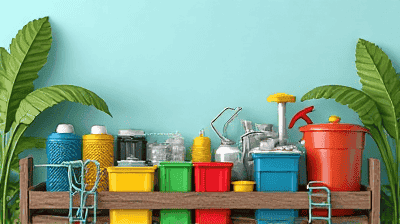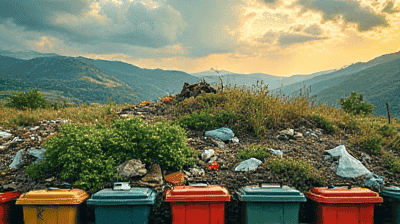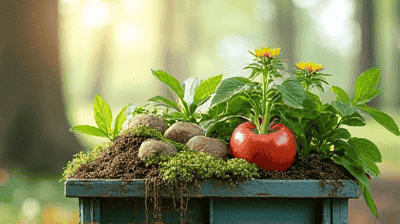
In an era where sustainability is at the forefront of global concerns, the concept of upcycling has gained significant traction among environmentally conscious individuals. Upcycling refers to the creative process of transforming waste materials or useless products into new materials or products of better quality or environmental value. By turning trash into treasure, not only do we reduce waste, but we also get to express our creativity and resourcefulness.
Upcycling is more than just recycling; it is the art of reimagining discarded items, often by giving them a new purpose. While recycling typically involves breaking down materials to create new products, upcycling preserves the original item’s integrity while enhancing its value. This creative process can apply to a wide range of materials, from glass bottles and cardboard boxes to old furniture and clothing.

Transform old glass bottles into stunning vases by painting them, wrapping them in twine, or adding decorative elements. Simply clean the bottles and paint them in your favorite colors, or wrap them in natural jute or hemp rope for a rustic touch.
Glass bottles, especially those with unique shapes, can make beautiful candle holders. Cut the bottle to your desired height and insert a candle or tealight holder. You can add sand or pebbles to the bottom for extra stability.
To create enchanting outdoor lighting, fill glass bottles with string lights and place them around your garden or patio. This adds a magical ambiance during evening gatherings.
Transform old t-shirts or denim jeans into durable tote bags. Cut the bottom of the shirt or the legs of the jeans, sew or tie the bottom closed, and you have a reusable shopping bag that showcases your personal style.
Old clothes can also be converted into unique pillow covers. Use colorful fabrics to create a patchwork design. This adds a cozy touch to your living space while reusing materials.
Cutting up old clothing into strips can create fun chew toys for pets. Braid the strips together to make a sturdy tug toy for dogs or a soft toy for cats.
Transform used cardboard boxes into stylish storage solutions. Cover them with fabric or decorative paper, and use them to organize items in your home or office.
Turn large cardboard boxes into a playhouse for children. Add windows and doors, let kids decorate it with paint or markers, and watch their imaginations come to life.
Cut cardboard into artistic shapes and use them as wall art. Paint or wrap them in fabric to create eye-catching decorative pieces for your home.
Repurpose plastic containers, such as yogurt or margarine tubs, into herb planters. Drill small holes for drainage, fill with soil, and plant your favorite herbs. These can be placed in your kitchen for easy access while cooking.
Create a simple bird feeder by cutting openings in a plastic container and hanging it from a tree. Fill it with birdseed, and enjoy watching the birds visit your yard.
Turn plastic containers into desk organizers by cutting and decorating them as needed. Use them to sort pens, paperclips, and other office supplies for a tidy workspace.
Old wooden pallets can be repurposed into charming garden benches or tables. Sand them down, paint or stain them, and arrange them in your backyard or patio.
Use pallets to create a vertical garden. Attach planters to the slats, fill them with soil, and plant flowers or herbs for a space-saving garden solution.
Create rustic wall art by painting or stenciling designs on disassembled pallet boards. Arrange the pieces in a geometric pattern for a contemporary look.
Clean and paint old tin cans to use as planters for small flowers or herbs. Punched tin cans can also provide drainage and add a rustic touch to your garden.
Transform tin cans into decorative pencil holders for your desk. Wrap them with fabric, paint, or decorative paper for a personal touch.
Use larger tin cans to manage kitchen utensils. Decorate them to match your kitchen theme, ensuring that your utensils are always within reach.
Repurpose old jars as spice containers. Label each jar for easy identification, and store them in your kitchen for a neat and organized spice rack.
Use jars to store cotton balls, swabs, or small toiletries in your bathroom. This not only keeps items organized but can also add a decorative element to the space.
Transform jars into beautiful night lights by adding string lights inside or placing a candle at the bottom. This creates a warm glow for nighttime ambiance.
If you are new to upcycling, begin with small projects that require minimal materials and effort. As you become more comfortable and creative, you can tackle larger and more complex projects.
Collect materials from your home that would otherwise be thrown away. Designate a specific area for collecting these items, making it easier to access them when inspiration strikes.
Explore online resources, social media platforms, and upcycling blogs for inspiration. Websites such as Pinterest offer a plethora of ideas for transforming everyday items into stunning creations.
Don’t hesitate to think outside the box. The beauty of upcycling lies in its boundless creative potential. Experiment with different techniques, colors, and styles to create something unique.
Engaging friends and family in upcycling projects can turn a simple task into a fun activity. Host a crafting party where everyone brings unwanted items and collaborates on upcycling projects together.
Don’t keep your upcycling projects to yourself. Share your creations on social media or community platforms. This not only encourages others to try their hand at upcycling but also fosters a community of like-minded individuals.

While the immediate benefits of upcycling are evident, there are also long-term advantages worth noting:
By reducing the amount of waste that ends up in landfills, upcycling contributes to lower greenhouse gas emissions and a smaller carbon footprint. This helps mitigate the impact of climate change and fosters a healthier planet.
Engaging in upcycling projects can lead to significant cost savings over time. Instead of purchasing new items, you can creatively reuse what you already have, resulting in reduced household expenses.
Upcycling encourages the development of various skills, including crafting, design, and problem-solving. These skills can be valuable in other areas of life, fostering personal growth and development.
Participating in upcycling activities can strengthen community ties. By working on projects together, neighbors can bond, share ideas, and create a sense of belonging centered around sustainability.
There is a unique sense of fulfillment that comes from transforming discarded items into functional or aesthetically pleasing creations. Upcycling fosters a sense of pride in one’s resourcefulness and creativity.
The journey from trash to treasure through innovative upcycling ideas is not only a creative endeavor but also a vital step toward sustainability. By incorporating upcycling into our daily lives, we can make a meaningful contribution to waste reduction, resource conservation, and community building. With endless possibilities and opportunities for personal expression, upcycling allows us to reimagine and repurpose items that would otherwise be neglected.
As we embrace this eco-friendly practice, it is essential to remember that every small effort contributes to the larger goal of creating a sustainable future. So gather those discarded items, unleash your creativity, and start transforming trash into treasure today.